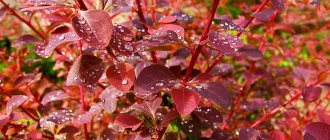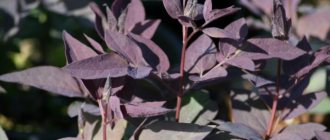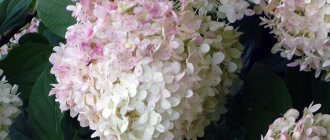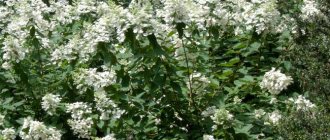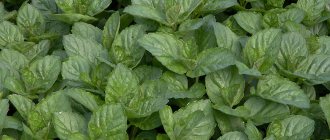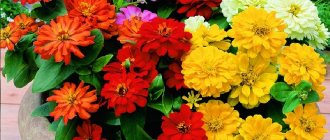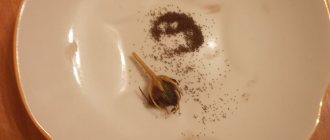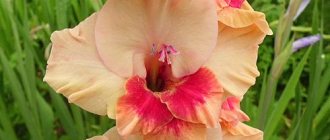Irga is one of the most promising berry bushes for cold climates. Productive, hardy, with sweet juicy fruits of delicious taste. Perhaps the only negative is that birds rate the taste of serviceberry berries no less highly than people. But what prevents us from planting shadberry for birds?
All types of serviceberry require a slightly longer or slightly shorter period of cold stratification. Another option is winter sowing in outdoor beds. With this type of sowing, the seeds germinate in the first or second spring. In summer, it is necessary to keep the soil in the seed bed moist and weed-free. This is the option I prefer whenever possible, because it significantly saves effort and time, and is also much more reliable in most cases.
- Irga tree-like
- Irga canadensis
- Irga Lamarca
- Irga alnifolia
Description of the shrub Iga
This bush can be considered a “newbie” on the territory of domestic summer cottages, but despite this, it is loved by gardeners. The tree grows quickly and has several trunks, is resistant to winter cold, unpretentious to conditions, is not susceptible to disease and has a bountiful harvest.
The shrub has oblong, oval, dark green leaves, which turn purple-orange in the fall and look especially decorative, and brown-gray bark. It blooms with white flowers, which are arranged in inflorescences in the form of brushes. The berries have a sweetish taste, are juicy, dark blue in color, and are arranged in up to 12 pieces on one cluster.
Flowering occurs in April-May, which makes the shrub very attractive at this time. During this period, it is not afraid of frosts that occur in the spring, and in winter the bush can withstand frosts down to -30 °C without additional hilling.
Description of the plant
The wood of the plant is not used in construction, but due to the excellent taste of the dark purple fruit with a bluish bloom, its former popularity is rapidly returning. Not only low-alcohol wine or liqueurs are made from them, but also medicines. Decoctions, infusions and alcohol tinctures are obtained from the fruits, bark and leaves. Dietary foods and culinary products are not complete without berries.
Folk remedies have a positive effect on the body:
- improve vision, digestion, sleep;
- strengthen the stomach and the entire body;
- increase immunity;
- eliminate deficiency of vitamins and microelements;
- prevent cardiovascular and gastrointestinal diseases (including ulcers), thrombosis;
- strengthen the walls of blood vessels and increase their elasticity;
- normalize heart function and reduce blood pressure;
- relieve inflammation in the body and oral mucosa, intestinal upset.
Useful properties of the plant
Irga is an excellent honey plant. Its berries contain more vitamin C than grapes, up to 12% sugar, a lot of malic and other organic acids, carotene, flavonoids, vitamins B, P, K, A, microelements, iodine, fiber, pectin, a large percentage in the seeds fatty oil. The fruits, bark and leaves contain tannins and dyes. The astringent properties of the leaves are used to treat pancreatitis with diarrhea; they are applied externally to wounds for speedy healing. The bark is crushed and boiled for the treatment of wounds and burns, gargling for inflammation and sore throat, and taken orally for gastrointestinal diseases.
Flowers are infused to strengthen blood vessels, increase their elasticity in the treatment and prevention of varicose veins and heart attacks, to lower blood pressure in hypertensive patients, and tonify the cardiovascular system. Fruits, fresh or dry, eliminate vitamin deficiency, strengthen the central nervous system: normalize sleep and reduce excitability, help cure kidney and liver diseases. Fruit juice relieves inflammation and diarrhea. It improves twilight vision, eliminates indigestion and inflammation of the oral mucosa during periodontal disease and gingivitis due to the high content of vitamin C and provitamin A. The berries are rich in beta-carotene, which is necessary for providing anti-atherosclerotic effects.
Contraindications
In addition to beneficial properties, berries have their contraindications. People who have low blood pressure should not indulge in fruits, i.e. hypotensive people Due to its calming effect, people with a sweet tooth should not overindulge in eating jam before driving a car, especially over long distances and in the evening and at night, so as not to accidentally fall asleep while driving.
During life, up to 60-70 years, full productivity of a fruit bush or tree occurs when it reaches 8-10 years of age and lasts 20-30 years. From one bush of 10-12 year old shadberry you can collect 8-14 kg of fruit. The plant is not only winter-hardy, but also drought-resistant, tolerates partial shade and calcareous soil. Grows well in fresh, fertile and moist soils, except swampy ones with standing water. A well-developed root system reaches a depth of 20-100 cm with a spreading radius of up to 2 m. Sometimes with individual roots the plant can reach a depth of 140-220 cm.
Irga is also valued for being the only source of vitamins and growing in areas where, due to cold weather conditions, apple, pear and plum trees cannot grow. Bushes or trees are planted either one at a time or in the form of a hedge.
What does irga look like - berries, flowers, leaves and shoots:
- Berry. It is round, diameter - 1-1.5 cm. While it ripens (not at the same time) - until the end of July - it is red, after ripening it is purple, almost black and has a bluish waxy coating. The pulp has a characteristic sweet taste with sourness, astringency and viscosity due to tannins. Dried berries, or popularly “curtains,” resemble raisins. The berries are used to make preserves, jams, juices, and culinary products.
- Escape. Young and thin erect red-brown shoots have a felt edge; they grow until the end of July and their growth in one season can be 60-100 cm.
- Leaves. They are held on long petioles and have a round, ovoid and oval shape, as well as teeth, reaching a length of up to 10 cm. When they bloom in the second half of April, they are brownish-green, in summer - bluish-green, in autumn - golden-purple.
- Flowers. The buds bloom along with the leaves. White or cream-colored flowers appear in corymbose inflorescences located at the ends of the shoots. They bloom for 10-15 days and can withstand temperatures of up to 5-7°C during spring frosts.
Types and varieties of serviceberry for the Moscow region: photos and description
There are 18 species of serviceberry in total (there is also information that there are 25). The shrub is classified as a member of the Rosaceae family, most of which are distributed in North America. It loves open sunny places, such as forest edges, mountain slopes, and can grow in tundra areas.
In our country, the following types and varieties of serviceberry are considered common:
Irga round-leaved (Amelanchier rotundifolia)
Irga spicata (Amelanchier spicata)
Serviceberry (Amelanchier canadensis)
Blood red serviceberry (Amelanchier sanguinea)
These varieties can be found running wild in nature, which grow there thanks to birds who love delicious fruits.
The listed varieties of serviceberry are suitable for the Moscow region, they “take care of themselves” perfectly, the main thing is to plant the tree correctly. They are not afraid of drought, strong winds and almost any unfavorable conditions, and all thanks to the root system, which penetrates to a depth of about 2 m and spreads within a radius of 2-2.5 m. It provides the plant with all the necessary nutrients and moisture.
What type of different varieties of irgi look like, look at the photo:
Let's look at a more detailed description of the varieties of serviceberry with photos.
Round-leaved
This shrub has many trunks, grows up to 4 m. It has smooth bark, dark gray color, oval, sometimes almost round leaves, which makes them similar to alder leaves. In autumn they turn bright yellow. It blooms white with a slight fragrance. The berries are very sweet, large, dark blue with a purple tint. The shrub can bear up to 10 kg of fruit per harvest, which is why it is considered the best variety of serviceberry.
Canadian
This plant is distinguished by its height, which can reach 8 m. It blooms with cream or white flowers that are odorless. The branches are thin, hanging down, the leaves are oblong, elliptical, and in autumn they become dark crimson, red, purple. The berries inside are dark pink, taste sweet, and you can harvest about 6 kg in one harvest.
Spiked
The bush is up to 5 m in height, has a dense oval-shaped crown, gray bark and matte dark green ovoid leaves. The flowers have a bright pink or white hue and are placed in racemes. The berries are dark red, almost black, with a bluish bloom. The plant begins to produce crops from the age of 4 years.
Blood red
Its berries have an irregular spherical shape, reminiscent of blueberries. They taste like unripe fruits, which even birds disdain. Despite this, they are very juicy, so they are used to make juice based on other fruits.
Taking into account the description of the types of serviceberry, the best varieties for the Moscow region are Canadian or round-leaved. But it is necessary to pay attention to some nuances. Since this shrub has a powerful root system, you will have to fight shoots all the time, so you should not plant this shrub near paths and buildings or decorative landscape elements. You should not do this for the reason that falling fruits leave dark spots.
Community of little green men
Amelanchier, Irga. A small tree or shrub with simple elliptical dark green leaves and small, bluish-tinged edible apples that first turn red when ripe and then turn bluish-black. It is grown as an early fruit and berry crop.
Etymology
The genus takes its name from the Provencal amelanche - the name of one of the species of serviceberry - round-leaved serviceberry, or common serviceberry.
Types and varieties of serviceberry
The genus includes 25 species. Most often, two main species are used in cultivation: Canadian serviceberry (Amelanchier canadensis) and alder serviceberry (Amelanchier alnifolia).
Serviceberry (Amelanchier canadensis)
The Canadian serviceberry is native to the east coast of North America. This is a low shrub up to 2 m in height with a wide rounded crown and large leaves that turn red in autumn. It blooms in late May–June for 7-10 days. The fruits are round, dark purple with a bluish bloom, sweet, edible. In culture since 1623.
Amelanchier alnifolia
A small tree or shrub that forms dense thickets in western and central North America. The bush is usually up to 2-4 m high. The fruits are almost black. Flowering and fruiting begin at the age of five. In culture since 1918.
Irga round-leaved, or currant (Amelanchier ovalis)
Shrub, up to 3-5 m high, with rounded leaves and sharp teeth along the edge, glabrous above, pubescent below. The flowers are white, the fruits are up to 0.8 cm in diameter, bluish-black with a bluish bloom. There are large-fruited forms.
Irga Lamarckii (Amelanchier lamarckii)
Shrub up to 8 m tall, the leaves are pinkish when blooming, later green, the fruits are edible, dark purple.
Irga spicata (Amelanchier spicata)
A tree no more than 5 m high, with a dense oval crown, the leaves are white-tomentose when blooming, dark green in summer, orange-red in autumn, fruits are reddish-black with a bluish bloom, sweet, edible.
Popular decorative varieties of serviceberry:
And. round-leaved: 'Helvetia' – shrub more than 1 m tall with a rounded crown, flowers up to 4 cm in diameter;
And. alder: 'Altaglow' - a variety with bright autumn color, 'Regent' - orange-yellow autumn foliage.
Serviceberry berries contain a whole complex of biologically active substances. Since the 16th century, shadberry has been cultivated in Europe and the USA for production purposes. In addition, serviceberry berries are an excellent treat for birds.
Popular fruit varieties of serviceberry:
'Mandan' – a variety with sweet fruits of late flowering;
'Pembina' – up to 3 m high, with large fruits;
'Smoky' – up to 3 m high, fruits up to 1.6 cm in diameter, sweet;
'Krasnoyarskaya', 'Slate', 'Pearson' and 'Honeywood'.
Irga care
Irga prefers sunny, well-lit places. Tolerates some shade when young. It is undemanding to soil conditions, resistant to lack of moisture and some waterlogging. Planting is best done in early spring or autumn. The root collar is buried 5-7 cm. After planting, the seedlings are pruned. Pruning is carried out in winter or early spring.
During the dry period, water 1-2 times a month, loosen shallowly (irgi has a superficial root system). Sanitary pruning consists of cutting out dry and damaged branches and root shoots. To rejuvenate, the bushes are pruned to the stump.
Irga is winter-hardy; some species are suitable even for the conditions of the Far North.
Reproduction of serviceberry
Propagates well by seeds, dividing bushes and winter cuttings.
Planting and caring for irga in open ground
Before you start growing this shrub, you need to familiarize yourself with the features of planting and caring for irga. She loves sunny areas and soil that is rich in organic amendments. Depending on preferences and care characteristics, you can form it into a bush or tree.
Planting and caring for irga in open ground has its own characteristics. For planting, seedlings 1-2 years old are taken and planted in prepared holes with a diameter of about 50 cm. The distance between plants should not be less than 1 m. After this, the seedlings are abundantly watered and mulched with peat or humus. A trunk about 10 cm long with 4-5 healthy buds remains above the ground.
See photos for some stages of planting irgi:
Planting a seedling in a prepared hole.
Pruning the seedling after planting.
Serviceberry seedlings for sale.
How to plant shadberry in spring
Features of planting and caring for irgi in the Moscow region correspond to general recommendations for planting and caring for trees in general. It is advisable to plant seedlings of this shrub in autumn. According to some experts, this can be done in March, when the weather conditions are favorable.
It is necessary to prune weak branches in a timely manner. In general, there should not be more than 2-3 healthy shoots on one trunk. At 3 years old, the bush should have about 15 branches. More mature plants can be periodically rejuvenated.
For planting irgi and care features, see the photo below, which shows the annual method of combating the growth of this shrub:
Young shoots, or “zero” shoots as they are also called, should be removed not above the surface of the earth, but near the root of the plant, except for those from which the bush is subsequently formed or with the help of which its rejuvenation is carried out in the future.
Irga Lamarca
Amelanchier x lamarckii Schroeder
The seeds sprouted in the second year after winter sowing.
PK94 Irga Canadian Lamarck Amelanchier lamarckii
During the summer, their growth was very uneven, which I tried to show in relation to my hand. Some seedlings barely reached 3 cm, others were 15 cm under the same conditions.
PK94 Irga Lamarca
Not all of the saplings survived the winter; many died. By July, the remaining ones had barely restored last year's size:
PK94 Irga Lamarca for the second year
How to grow shadberry from seeds
Planting irgi and caring for it, as well as propagation, is not a difficult process not only for professional gardeners, but also for beginners. The shrub can be propagated by seedlings, which can be purchased or grown from seeds. The seeds are planted in fertilized beds and then watered well. When the seedlings reach 1-2 years of age, they are planted in a permanent place.
Growing serviceberry does not require special skills, the main thing is that the plant begins to grow when planting; further care consists of feeding, forming the crown, pruning weak, old or dry branches, and thinning the bush.
If you are interested in how to plant shadberry from seeds, you need to know how to properly prepare them for planting. To prepare the seed material, ripe fruits are taken, wiped and washed with cool water. Bad seeds usually float to the surface. The washing procedure must be carried out until the good ones remain at the bottom.
You need to know how to properly plant shadberry using seeds if you choose this method of propagation. About 300 seeds need to be sown in a furrow one meter long to a depth of 1.5-2 cm. Sowing is done in early spring, sometimes at the end of winter, and you can wait almost a year for the shoots to appear.
Every gardener should know how to grow shadberry when the seeds have sprouted. Seedlings that grow 3-5 full leaves are picked and grown until they are 1-2 years old. Bushes grown from seeds are characterized by uniformity. Presumably this is caused by asexual reproduction (apomixis).
Propagation of irgi by cuttings and root shoots
The easiest way to propagate irgi is to use shoots from the roots for planting, which have to be removed every year. This bush requires a living area of 2.5-4 m, leaving 1.5-2 m between future shrubs. In nurseries, seedlings are planted in a checkerboard pattern.
The work consists of choosing suitable root shoots, the diameter of which should not be less than 0.5 cm and the length 10-15 cm. It is important that the roots are healthy and well developed. The buried seedlings are watered well so that the humidity is constantly at a high level.
For this method of propagation, shoots that are no more than 6 years old are suitable. It is suitable for amateur gardeners who are interested in how to plant shadberry in the spring by dividing the bushes, because no more than 4-6 full-fledged cuttings are obtained. In nurseries, preference is given to propagation by seeds in order to obtain a larger number of seedlings.
Propagation of irgi by cuttings involves selecting branches that are no more than one year old and 12-15 cm long. It is necessary to prepare a special greenhouse with a special soil mixture. The bottom is covered with a layer of pebbles (30-40 cm), then a mixture of light soil with humus (25 cm) is poured, and the top is covered with sand (4-5 cm).
Planted and well-watered cuttings are covered with film until roots appear. This usually happens around the 25th day, depending on the variety. To speed up the appearance of roots on cuttings, they are treated with special solutions. Rooted cuttings are planted in open ground the next year.
Despite the fact that growing and caring for this shrub does not require much effort, it is still necessary to carry out some standard actions, such as fertilizing, pruning and protection from pests and birds. Birds love to feast on ripe fruits, so when you want to get a harvest, you need to cover the bush with a fine net.
Growing and caring for irga consists of properly applying fertilizing in the summer. The nutritional composition should be liquid, prepared from ammonium nitrate, 50 g of which is used per bush or 5 liters of 10% bird droppings emulsion. Fertilizing should be done at night, when there has been heavy watering or it has rained.
